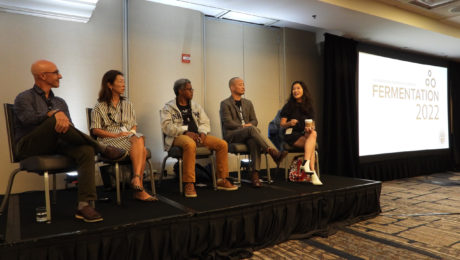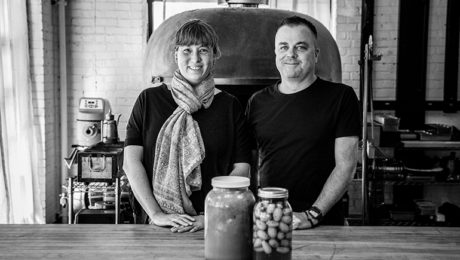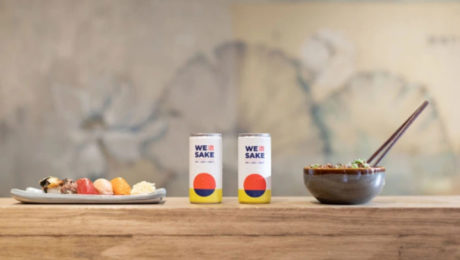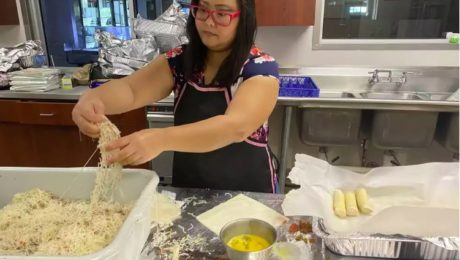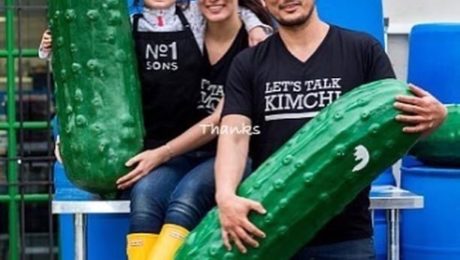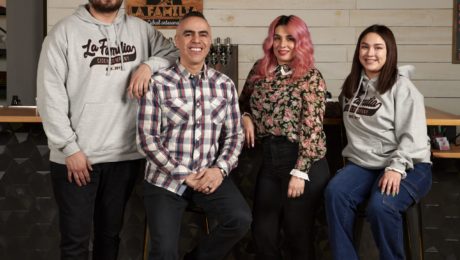Replacing Meat
Popular Science advises it’s time people swap animal protein for fungi. The article focuses on the environmental benefits of fermented meat alternatives, as they could help cut deforestation.
A recent study published in Nature estimates annual deforestation may be cut in half if 20% of per-capita meat consumption is substituted with microbial protein by 2050. This substitution would offset the expected increase in CO2 emissions in pasture areas around the globe.
“The production of ruminant meat requires large areas for cattle grazing or growing its feed on cropland, which causes deforestation, biodiversity loss, and CO2 emissions,” says Florian Humpenöder, study author and senior scientist at the Potsdam Institute for Climate Impact Research. “Today, almost 80 percent of global agricultural land including cropland and pasture is used for feeding livestock.”
Popular Science points out a difficult truth: though microbial protein uses far less land and much lower greenhouse gas emissions compared to traditional meat, “its energy consumption is almost equal to that of beef production. The entire process of microbial meat production — which includes electricity generation, microbial cultivation, bioreactor stirring and cooling, and the eventual downstream processing of biomass and proteins — requires energy.”
Lutz Grossmann, assistant professor in the Department of Food Science at the University of Massachusetts Amherst, says this cultivation process needs to be designed sustainably. Humpenöder suggests electricity generation needs to be decarbonized on a large scale, and renewable energy sources should be considered in alternative meat production. If this doesn’t happen, substituting microbial protein for traditional animal meat will not lead to a decrease in energy-related greenhouse gas emissions.
Read more (Popular Science)
- Published in Business
Promoting Fermentation Innovation
Several obstacles prevent the innovation of fermented foods, from the lack of scientific research to a chasm between science and industry to improving the sustainability of traditional ferments.
A third of foods consumed worldwide are fermented, totalling 3,500 products. A group of European scientists is studying how those fermented foods can drive innovation in food systems.
“There’s not a clear way to improve the unique properties of traditional fermented foods using microbial organisms,” says Vittorio Capozzi, PhD, a researcher with the Institute of Sciences and Food Production (ISPA) in Italy. “We still need innovation in traditional fermented foods.”
Capozzi was one of the presenters at a side event during the October Food & Agriculture Organization of the United Nations Science and Innovation forum. PIMENTO hosted the session. PIMENTO (which stands for “Promoting Innovation of ferMENted fOods”) launched last year in Europe, a project of the European Cooperation in Science and Technology (COST). PIMENTO aims “to place Europe at the spearhead of innovation on microbial foods” by promoting fermentation’s health, diversity and production. To achieve this goal, five working groups are structured around different fermentation topics. The groups are made up of both scientist and non-scientist fermentation experts studying and eventually implementing their findings.
Traditional ferments have “an important part of biodiversity that we cannot neglect,” Capozzi says. Fermentation provides new microbial-based solutions for a variety of foods, from plant-based ferments to alternative proteins. Innovations can improve nutrition and sensory qualities.
“In this way we are preserving biodiversity that has huge potential in biotechnology, science and innovation,” he says.
Ferments, he notes, can be protected. For example, a ferment produced in a specific geographical region (tequila in Mexico), a protected diversity, vegetable type, animal product or the human behavior used in production (Salers cheese in France).
“Fermented foods have been shaped through the centuries,” says Effie Tsakalidou, professor at the Agricultural University of Athens in Greece. “We have a lot of diversity.”
One of PIMENTO’s tasks is to create a database on European fermented foods. This list would include food types, production, consumption volume, technological parameters and legal status (like certifications).
Speaking on the health benefits and risks of fermented foods, Smilja Todorović, PhD, a professor at the Institute for Biological Research in Serbia, notes there’s a dearth of reputable, peer-reviewed studies on fermented foods.
“One of the very important things is to identify gaps in scientific evidence regarding benefits and risks,” she says.
The current studies on fermented foods are few and limited. Research does prove consuming fermented foods is correlated with overall mortality, decreased risk of diabetes, certain cancer types, high blood pressure and cardiovascular diseases. Todorović says that’s not enough.
“Unfortunately, when we look at scientific evidence to claim health properties, we can see that there are insufficient evidence. So all we have is a growing scientific interest in fermented foods and their impact on human health. However, we need to move from promising results to scientific evidence,” he says.
PIMENTO’s working groups are cataloging fermented foods’ impact on the gastrointestinal symptom, allergies, immunity, bone health and neurological projects. They also plan for projects studying fermented foods bioactive compounds, vitamin production and functionality; and fermented foods use in personalized diets.
The lack of studies prevents innovations in the field. Antonio del Casale, co-founder and CEO of Microbion, an agro-industrial microbiology company, says there is a disconnect between the scientists studying fermented foods and fermented food producers. He calls it “a valley of death.” The research on fermented foods is low, but the development of commercial resources are increasing.
“The problem is how to avoid the limitations of developing the food in this sector,” he says.
Traditions of Fermentation, Cultural Appropriation & Diversity
Cooking isn’t limited to only making the dishes of one’s ethnicity. The cultural identity of that food becomes murky when it gets transactional. Commercializing a food without respecting and honoring its history and tradition is inauthentic, damning to immigrant producers and threatens to erase traditional foods.
“Someone with more power or dominance, they can create their own kimchi – that doesn’t have any resonance to its tradition – and get it on the shelves of Wal-Mart and make it commercially successful. I don’t have that opportunity because I’m a woman, I’m Korean, I’m a minority and I’m just trying to tell the story about kimchi in my way,” says Lauryn Chun, founder and CEO of Mother-in-Laws kimchi. Chun’s kimchi comes from her mother’s recipe used in the family restaurant in California, Jang Mo Jip. “It’s my heritage of food that I enjoy sharing with Americans.”
Chun’s experience is similar to many BIPOC producers. It’s difficult for minority producers to compete with the white-owned brands that often have more money to launch a food company and receive preferential treatment by retailers for store placement.
“When you turn it into a business and you’re profiting as a company, we need to be more sensitive and more deliberate in how we give credit to people,” adds Robert Danhi, chef and co-founder of Flavor360 Solutions (and a TFA Advisory Board member)
Speakers discussed the wide range of issues related to traditional foods in a panel during TFA’s conference FERMENTATION 2022 titled “Traditions of Fermentation, Cultural Appropriation and Diversity.” Panelists included Chun, Danhi, Beverly Kim (chef and owner of restaurants Parachute and Wherewithall in Chicago), Kheedim Oh (founder of Mama O’s Premium Kimchi and TFA Advisory Board member) and Ismail Samad (founder of Loiter and Wake Robin Foods). The discussion was moderated by Josephine Wee (assistant professor at Penn State University and a TFA Advisory Board member).
Do Cultures Own Their Foods?
“There’s appropriate appropriation,” says Oh, whose Brooklyn-based kimchi brand is also based off the recipe of Oh’s mother, a Korean American. “Some of these brands, is what they’re making even kimchi? Kimchi is such a popular buzzword now. But it’s an unfair advantage when you’re competing with me and Lauryn to get your kimchi on the shelf and it’s very loosely kimchi.”
Brands are coming to retail with condiments labeled kimchi that are far from the traditional Korean condiments. They’re skimping on ingredients, like not using traditional Napa cabbage and opting for cheaper produce varieties. Though there’s hundreds of versions of traditional kimchi, some brands are veering too far to gain sales (Oh joked about a raspberry cheesecake kimchi).
“We need to change the narrative from appropriate to appreciation, celebration and preservation,” Wee adds.
Should a culture own a fermented food? Like Koreans just selling kimchi? The panel didn’t agree with that notion. But Samad points out a culture’s food is taken away from them when it’s exploited.
Through his nonprofit Loiter, Samad tackles the effects of systemic racial and economic injustice. He’s helping the residents of East Cleveland by developing successful, community-owned businesses – like Wake Robin Foods, a fermented food brand Samad purchased. Wake Robin will create ferments using produce from local, urban farmers.
“It’s black owned by black farmers so we can get some black dollars circulating in our culinary economy so they can have some freaking version of reparations for what has happened,” Samad says. “For me this is straight financial, who gets the opportunity to scale up.”
Samad says there’s an entire food system of African fermented foods “not being appropriated or appreciated in the U.S.” He hopes to disrupt the market.
“There’s an opportunity to introduce products that are owned by own by us, and by us I mean the African Diaspora,” he says.
Nuances in International Dining
Many American diners, though, are “still even at the elementary level of understanding the differences between different cultures in a diaspora,” says Kim, a former Top Contestant. “Asian cuisine is not just one monolithic cuisine.”
Some pan-Asian restaurants sell sushi (Japan) alongside kimchi (Korea) and pad thai (Vietnam), a “mish mash” of foods from different Asian countries. “We have to “continuously dig deeper to show there are nuances between the cultures,” she says.
It can be a difficult concept for chefs, too, who are trained in primarily French cuisine at culinary school. When Kim went through culinary school, a short quarter was focused on global foods, “the rest is basically Fresh cuisine.”
Ethnic food — especially Asian fare— the food is often stereotyped as cheap, “it’s a bamboo ceiling that you can’t charge high prices,” Kim says. Western diners often don’t take into account the differences in quality of ingredients or the creativity, care and time in cooking a dish. “We’ve been seen as cheaper because we’re Asian, so people question why our prices are so high.”
Chun, who grew up helping in the family’s Korean restaurant, began Mother-in-Law’s kimchi questioning why kimchi wasn’t in the ranks of specialty craft foods like fine cheese.
“From the perspective of western fermented foods, from cheeses to wines to craft beers, those are the only things people are willing to spend their money on,” Chun says. She adds she felt very proud to be the first kimchi in specialty grocery store chain Dean and Deluca.
In retail, many international food brands get placed in the ethnic aisle. But why does a sauce from an international region get placed in the ethnic aisle while spaghetti is placed in the sauces aisle?
“I’m torn over the concept of that existing,” Oh says. “We’ve been subjugated to the ethnic aisle aka the global ghetto where there’s no reason for it except the fact that I’m Korean.”
Cultural Regulatory Bias
Are there conflicts between tradition and science? Panelists shared how some health regulators don’t understand cultural ferments, causing batches of fermented food to be deemed unsafe for human consumption and thrown out.
Kim attempted to start a wholesale kimchi brand during the brand. Studies prove kimchi is made safely at a pH range of 4.2-4.5, but the regulator from the health department was told Kim legally had to keep kimchi under pH levels 3.3 to keep it safe.
“There’s so much confusion around it, I had to reach out to food scientists to clarify it, and we don’t want to get in trouble,” Kim says. She ended up cancelling the brand because securing regulatory approval was so difficult.
Oh adds: “I think there’s a big cultural bias when it comes to fermented foods. In the U.S., it’s either the food is 100% clean scrubbed and pasteurized or it’s not – and the not is dangerous and dirty. Where fermented foods predates modern electricity and modern science, there’s a reason why it’s safe because it works out that it’s a very safe food because, through the lactic acid fermentation, it lowers the pH and that helps preserve the food.”
- Published in Business, Food & Flavor
Bean-free Chocolate & Coffee
The front page of the Financial Times featured a new wave of alternative foods: chocolate and coffee, but without the beans.
Cultivating both cocoa beans for chocolate and coffee cherries for coffee at such a high rate for global consumption is damaging to the environment. It’s linked to deforestation. The working conditions for many of the farmers are also deplorable, with child and slave labor and poor wages. Now multiple startups are trying to make a market for bean-free products.
“You realise that a lot of our favourite foods, whether it’s beef burgers or a cult of coffee or a chocolate bar, there’s so much damage,” said Johnny Drain, chief technology officer of WNWN Food Labs, a London-based maker of cocoa-free chocolate. “Not just to the climate but to the people, typically in developing countries who are producing those products for us.”
Drain is a fermentation expert who formerly worked with restaurants to make unique flavor profiles using fermentation. He’s founded WNWN with Ahrum Pak, a former financier now working in the foodtech space with Drain (both pictured). Their chocolate is made from fermented barley and carob.
More startups are, too, trying to be a solution to an unhealthy chocolate and coffee industry. In Munich, Planet A developed a cocoa-free chocolate which has chief ingredients of fermented oats and sugar beet. They call it “Nocoa.” In the U.S., Voyage Foods and California Culture make chocolate from lab-grown cocoa.
Bean-free coffee, meanwhile, has been created by two U.S. startups – Atomo in Seattle uses date seeds, chicory root, grape skin and green tea to create a canned cold brew coffee. Compound Foods in San Francisco. The latter is recreating coffee using synthetic biology and fermentation.
“We want to give consumers a choice,” said Andy Kleitsch, co-founder of Atomo, who added that although they had been worried that “the coffee industry would hate us or that the baristas might hate us, the reception has been positive”.
Many of these entrepreneurs note alt products are not the only solution to an environmentally-damaging food industry. Drain adds: “It’s just one additional way of trying to change an industry that is built on inequity and slave labour.”
Read more (Financial Times)
- Published in Business, Food & Flavor
Reducing Waste, Cost with Fermentation
After hiring a fermentation expert to help reduce food waste, Id Est Hospitality Group saw their food cost drop from 32% to 22%. Kelly Whitaker, founder and chef, hired Mara King, fermentation specialist (both pictured), to pursue a zero waste model in the group’s different restaurants. Whitaker points out he doesn’t like using the term “waste” but “other products” instead.
King is chef, co-founder of fermented food business Ozuké, educator and producer of the YouTube series “People’s Republic of Fermentation.” She notes in a climate like Boulder, Colo., preserving food is key.
“As a fermenter, one of the first things Kelly wanted me to dive into was seasonality,” said King. “We live in Colorado and it has a short growing season compared to other places in the world.”
King began a large-scale preservation project at Id Est Hospitality Group, using the produce from local farmers to fuel ideas. For example, she made a vinegar using the discarded peels of 200 persimmons and a hot sauce with more than 90 pounds of 100 types of chiles, with the chiles prepared in different ways (preserved, roasted, frozen or dried).
Read more (Restaurant Hospitality)
- Published in Business, Food & Flavor
Is the Future of Sake Canned?
Despite dedicated U.S. sake programs and educated American sommeliers, sake has been a harder sell in U.S. Federal regulations have never been able to properly define the drink. It’s taxed as a beer, but regulated as a wine. Education is a big issue. Many Americans think sake is a wine, causing them to drink too much of it and feel sick. Sake is brewed from fermented rice, making it similar to a beer.
“There’s a learning curve, but there’s also a bit of a cultural barrier. Sake can come across the way wine can — this very sophisticated product that’s expensive and that’s a bit esoteric, like you can’t really appreciate it unless you know all the nomenclature,” says Weston Konishi, president of the Sake Brewers Association of North America. “And then there’s the fact that Japanese sake tends to be labeled in Japanese, which most Americans can’t read. That’s been something of a barrier.”
Now more sake brewers are putting their sake in cans, making easy-to-purchase, grab-and-go options. It’s cheaper, too, at $5 a can versus $30 for a bottle.
“There’s something less intimidating about a can versus a bottle — that’s one advantage to canning sake. It’s not so erudite and out of reach,” says Konishi.
Inside Hook highlights six brands selling sake in cans.
Read more (Inside Hook)
- Published in Business
Food Regulations Fall Short on Diversity
The laws around food production are confusing, costly and “don’t reflect diversity in food.” Cottage food producer laws allow budding chefs to start making ferments for retail sales, “but only if they’re made a certain way.”
An article in Minnesota Public Radio highlights a major gap in food regulation: immigrants are left out. Though food laws cover fermented kimchi and kombucha, for example, they’re restrictive for less common fermented foods and beverages from different cultures. Vino Raj, owner Square Root of Curry in Minnesota, points out that if he tried to make a fermented product from his native country, he’d have to “fundamentally change” the product to follow the state’s rules, “rendering them inauthentic.”
“You don’t see lots of South Indian foods because of that law,” he said. “The laws have not caught up to other forms of cooking.”
The barriers for immigrants wanting to start a small food business are especially high. Procedures often aren’t translated into other languages, commercial kitchens are challenging to find and expensive to rent, insurance and licensing is costly.
Pictured, Dao See, owner of Minne Street Rolls, sells traditional Lahu food and is advocating for Minnesota to sell more diverse food.
Read more (Minnesota Public Radio)
- Published in Business
Making Resilient Brands in Economic Downturn
Natural food sales continue to balloon since the Covid-19 pandemic, but food producers should not get comfortable yet with the wellness-minded consumer. Brands need to brace for what’s coming. With inflation, supply chain challenges and a looming recession, brands must remain resilient in the changing economy.
“Even in the face of a recession, growth is continuing,” says Carlotta Mast, senior vice president of New Hope Network (a division of Informa PLC), which produces Natural Products Expo West. “People are not expected to ‘trade down’ from health.”
Sales in the natural and organic products industry grew 7.7% in 2021 to reach $272 billion. Estimates put the industry at hitting $300 billion in sales in 2023. The stats were presented during the State of Natural & Organic Industry presentation (presenters pictured) at Expo East, the natural products show hosted in Philadelphia this year. More than 1,100 brands exhibited at the expo, many capitalizing on the growing wellness and functional foods trends.
Functional food and beverages – the subcategory where fermented products reside – continues to be a bright spot in the natural products space. Functional food and beverage sales are driving 70% of natural product sales. Functional sales grew 8.3% to $83.7 billion in 2021, with sales on track to reach nearly $100 billion by 2024. Functional food and beverage – like kombucha, drinking vinegars and probiotic sodas – is the top growth category in functional.
“This is truly a hot spot for our consumers,” Mast says. “People are expecting their foods and their products to have real health benefits.”
Natural products are outpacing growth of conventional products. Over 60% of CPG brands launched in the last year have a health and wellness focus. Natural products are also leading sales in all retail channels – natural, regional grocery, conventional multi-outlet and convenience stores.
“Everywhere we buy, were all buying more natural products and it’s outpacing mainstream growth which is really encouraging as we go forward,” says Kathryn Peters, executive vice president at SPINS (a data provider for natural, organic and specialty products).
Of note, online sales of CPG have returned to pre-pandemic levels, proving brick and mortar sales still reign supreme. Natural products are purchased online at two times a higher rate than conventional products, proving a multi-channel strategy is needed for brands.
- Published in Business
10 Year Old Ferment Brand Shuts Down
After 10 years in business, DC-based ferment shop Number 1 Sons has closed, victim to one of the hardships for many small food producers: operation woes.
Number 1 Sons exclusively sold at farmers markets. Their seasonal ferments ranged from pickles, sauerkraut, kimchi, kombucha and vinegar.
They were one of the early adopters of home delivery when the pandemic hit, investing in six refrigeration vans and making over 30,000 home deliveries in 2020 and 2021. In 2022, they returned to selling at farmers markets. But owners and siblings Yi Wah and Caitlin Roberts said in a statement that they can no longer operate in their current space.
“Since 2012, we’ve made pickled and fermented food and drink that we’ve brought to our neighbors at farmers’ markets across the Washington DC area,” they said. “In the spring of 2020, we transformed overnight from a farmers market pickle company into a pandemic grocery delivery business. Such a business transformation is only possible with incredible community or massive resources. Guess which one we had? Our customers trusted us.”
In a statement, Wah and Roberts said: “many businesses are facing rising costs and an increasingly challenging business environment – we recognize our fellow food businesses that are continuing to evolve, innovate, and grind it out. Local independent businesses are key fibers in the community tapestry.”
“We are thankful, and in awe, of our customers, crew, fellow market businesses, and partners (microbes too!) who have been a part of this salty little thing. It’s been a gift to do this with you.”
Read more (Washingtonian)
- Published in Business
Mexican Hard Cider
An Oregon cidery is taking an interesting approach to hard cider, ciders inspired by aguas frescas.
La Familia Cider Company founder José Gonzales is a first-generation Mexican-American. He runs La Familia Cider Company with his wife, Shani, and their kids Jay Jay and Jezzelle. José and Shani grew up drinking aguas frescas, but couldn’t find those drinks in Oregon.
“As my wife and I were enjoying Oregon craft beer and cider, she said, ‘Too bad there aren’t any of the flavors we grew up with,” José said. So they developed their own brand with flavors reflecting their heritage.
Their ciders are from freshly-picked, northwest-grown apples, but the flavors reflect the family’s Mexican heritage. Mainstay flavors include Manzana, Tamarindo and Hibiscus.
“With our ciders we wanted to do something a little bit different,” explained Jay Jay. “Change up the game a little bit.”
Today, the Salem, Ore.-based brand is in more than 50 stores in Oregon and Washington.
Read more (KGW8)
- Published in Business, Food & Flavor



